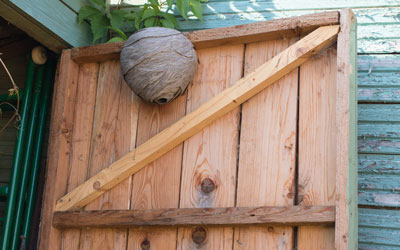 Wasps are one of the most common summertime pests, especially here in the Northern Utah and Southern Idaho area. Normally a beneficial part of the environment, wasps can create a hazardous environment when they build their nests in residential areas. There are a few different types of wasps in our areas, and they all build different kinds of nests. Although it’s important to never approach a nest, it’s also important to learn how to identify them. The team at Rentokil is here to help you learn how to identify wasp nests.
Wasps are one of the most common summertime pests, especially here in the Northern Utah and Southern Idaho area. Normally a beneficial part of the environment, wasps can create a hazardous environment when they build their nests in residential areas. There are a few different types of wasps in our areas, and they all build different kinds of nests. Although it’s important to never approach a nest, it’s also important to learn how to identify them. The team at Rentokil is here to help you learn how to identify wasp nests.
Most Common Wasp Nests
In our region, we are used to seeing a variety of wasps. The main ones are mud daubers, paper wasps, bald-faced hornets, and, of course, yellowjackets! The main differences between these wasp nests are:
- Mud daubers. Solitary female mud daubers build nests out of—you guessed it—mud! The nests are small and tubular in size, often looking like organ pipes. They are typically found in cracks or crevices.
- Paper wasps. Their nests famously look like upside-down umbrellas. These nests are often open, and can get quite large in size. They are typically supported by a single stalk and consist of a paper-like material.
- Bald-faced hornets. These nests are almost always at least three feet off the ground. They are made of chewed wood fibers mixed with saliva. They often grow to be the size of a football or basketball.
- Yellowjackets. Nests are a papery material and have a single opening. The inside of a yellowjacket nest can have up to 100 tiers of cells. Yellowjackets can also build underground nests that can be enormous in size.
Where to Look Out for Wasp Nests
A wasp nest can be in a wide variety of places. Yellowjackets favor areas near the ground, in hollow trees, under porches, and a number of other areas. Mud daubers tend to build their nests in sheltered areas, including under eaves, garages, attics, or on the sides of buildings.
Paper wasp nests are often located under and within the eaves of structures, in attics and wall voids, and in other enclosed areas. Bald-faced hornets, on the other hand, like to build nests high up off the ground. This can mean in trees, but also on structures. In general, wasps tend to favor sheltered spots for their nests.
How to Get Rid of Nests
Bottom line: it’s important to never attempt to knock down or get rid of a wasp nest on your own. Even if it’s small or appears abandoned, there could be more stinging insects inside than you realize. Many types of wasps will sting repeatedly—disturbing them will make them more likely to do so. It’s safe to simply call your local wasp control experts at Rentokil when you need help with wasps.
How Do You Identify Wasp Nests? in Salt Lake County and Northern Utah
Serving Northern Utah and Southern Idaho since 1999

